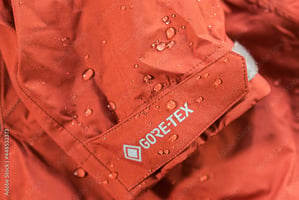Please imagine : you're out in the great outdoors, surrounded by breathtaking landscapes, and it...
The Science Behind Gore-Tex: Unraveling the Technology That Keeps You Dry
Are you tired of getting soaked in the rain or feeling sweaty and uncomfortable during outdoor activities? Look no further than the incredible technology of Gore-Tex. This revolutionary fabric has become synonymous with waterproof outerwear, providing the perfect balance between protection and breathability. In this article, we will delve into the science behind Gore-Tex and unravel the technology that keeps you dry.
Using a unique membrane technology, Gore-Tex allows water vapor to escape while preventing external moisture from penetrating. This means you can stay dry even in the most intense rainstorms or strenuous activities. But how does it work? We will explore the intricate details of the Gore-Tex membrane and the innovative manufacturing process that creates a barrier against water molecules while still allowing air to pass through.
From outdoor enthusiasts to professional athletes, Gore-Tex has revolutionized the way we stay protected in extreme weather conditions. Join us as we uncover the fascinating science behind Gore-Tex, and discover how this technology continues to keep us dry and comfortable on our outdoor adventures.
How does Gore-Tex work?
The key to Gore-Tex's exceptional performance lies in its unique membrane technology. The Gore-Tex membrane is made up of millions of microscopic pores, which are 20,000 times smaller than a water droplet and 700 times the size of a water vapor molecule. This size difference allows water vapor to escape through the membrane while preventing external moisture from penetrating.
The secret lies in the structure of the membrane. Each pore is surrounded by a hydrophobic (water-repellent) material, which prevents water from entering. At the same time, the pores are large enough to allow air molecules to pass through, ensuring breathability. This combination of water resistance and breathability makes Gore-Tex the go-to choice for outdoor enthusiasts and athletes alike.
But how does the membrane manage to keep water out while allowing air to pass through? The answer lies in the principle of diffusion. Water vapor molecules naturally move from an area of high concentration (inside the garment) to an area of low concentration (outside the garment). The Gore-Tex membrane acts as a barrier, allowing this diffusion process to occur while blocking the larger water droplets from entering.
It should be noted that Gore-Tex's ability to repel liquids and water is called DWR, which is different from Gore-Tex's original performance. The essence of Gore-Tex is a membrane, which is laminated to another fabric to protect it from direct damage. DWR is then applied to the fabric that it protects. And it should be noted that if the DWR is reduced, the Gore-Tex membrane will not perform as well.
The history and development of Gore-Tex
The story of Gore-Tex begins in 1969 when Bob Gore, a chemical engineer, discovered a new form of expanded polytetrafluoroethylene (ePTFE) during an experiment. This ePTFE had a unique structure consisting of interconnected nodes and fibrils, creating a microporous material with exceptional properties.
Bob Gore and his team realized the potential of this material and developed it into a waterproof, breathable fabric. In 1976, they introduced the world to Gore-Tex, revolutionizing the outdoor industry. Since then, Gore-Tex has continued to evolve, with ongoing research and development improving its performance and expanding its applications.
The benefits of Gore-Tex
The benefits of Gore-Tex are numerous and make it the preferred choice for outdoor enthusiasts, athletes, and professionals who rely on durable and high-performance gear. Here are some key advantages of Gore-Tex:
- Waterproof: Gore-Tex provides reliable waterproof protection, keeping you dry in even the most extreme weather conditions. Whether it's heavy rain, snow, or standing water, Gore-Tex has you covered.
- Breathable: Unlike traditional rain jackets or waterproof fabrics that trap heat and moisture, Gore-Tex allows water vapor to escape, keeping you comfortable and dry from the inside out. This breathability is essential during physical activities to prevent overheating and sweat buildup.
- Durable: Gore-Tex is known for its durability and longevity. The fabric can withstand rough outdoor conditions, abrasion, and repeated use without losing its waterproof and breathable properties.
- Versatile: Gore-Tex is not limited to just outerwear. The technology has been adapted for footwear, gloves, and accessories, providing comprehensive protection in various outdoor activities.
- Windproof: The tightly woven structure of the Gore-Tex membrane acts as a wind barrier, preventing cold air from penetrating and reducing wind chill. This added protection is crucial in harsh and windy conditions.
- Comfortable: Gore-Tex garments are designed to be lightweight, flexible, and comfortable to wear. The fabric moves with your body, allowing for unrestricted movement and enhancing your overall outdoor experience.
Gore-Tex's combination of waterproofness, breathability, durability, and comfort sets it apart from other waterproof materials.
Gore-Tex vs. other waterproof materials
When it comes to waterproof materials, Gore-Tex stands out for its superior performance and technology. Let's compare Gore-Tex with other common waterproof materials to understand the differences:
- polyurethane (PU) coating: Polyurethane (PU) coated fabrics: PU coated fabrics provide a certain degree of waterproofing, but they fill in the fabric's grain, so they lose their breathability. They also deteriorate chemically quickly, even when not in use, due to moisture, temperature, and UV rays. In contrast, Gore-Tex membrane technology provides long-lasting waterproofness and breathability.
- polyvinyl chloride (PVC): PVC, like PU coating, is a waterproof coating that is not breathable. PVC is a more durable and waterproof material than PU coating, but it is also heavier and stiffer. Gore-Tex, on the other hand, is breathable, comfortable, and flexible.
- DWR-treated nylon or polyester: DWR-treated fabrics repel water but are not waterproof. Water repellency and water resistance are two different scientific phenomena; DWR takes full advantage of the surface tension of liquids, so it is not waterproof enough to keep water out under pressure.
- rubber or neoprene: Rubber or neoprene is very waterproof but not breathable. They are also highly chemically stable, but they also carry weight. As such, they can cause excessive sweating and discomfort during exercise. Gore-Tex breathable membranes allow moisture vapor to escape, enhancing comfort and performance.
- wax Waxed fabrics can easily add waterproofing properties. However, they must be rewaxed periodically to maintain their performance. It is possible to have a certain level of waterproofness, but it is difficult to achieve a high level. Gore-Tex technology eliminates the need for such maintenance for waterproof performance and provides long-term waterproof protection.
Gore-Tex's combination of waterproofness, breathability, and durability makes it the clear choice for those seeking reliable and high-performance outdoor gear.
Common misconceptions about Gore-Tex
Despite its widespread popularity, there are some common misconceptions about Gore-Tex that need to be addressed:
- Gore-Tex is not breathable: This is a misconception. Gore-Tex is not breathable: This is a misconception. Gore-Tex is breathable and allows moisture vapor to escape, keeping you dry and comfortable during exercise. It should be noted, however, that breathability can be affected by fabric clogging (due to dirt and sweat) and DWR performance factors. In other words, the breathability listed in the catalog is only for new products, and maintenance is required to maintain breathability during use.
- Gore-Tex is for extreme conditions only While Gore-Tex excels in extreme weather conditions, there are models available that are also suitable for everyday use. Gore-Tex's waterproof and breathable properties provide reliable protection and comfort whether you are commuting to work, running errands, or taking a leisurely hike.
- Gore-Tex is too expensive: Gore-Tex products may be on the higher end of the price range compared to non-technical materials, but they offer superior performance, durability, and longevity. Understanding Gore-Tex products and proper maintenance will ensure years of reliable protection.
- Gore-Tex requires special care: This is true to some extent. Although Gore-Tex is designed to withstand normal use, it does require maintenance to maintain its original performance. Proper care and maintenance, including routine cleaning and periodic reapplication of the DWR treatment, will prolong the life and performance of Gore-Tex gear.
It's essential to understand the facts about Gore-Tex to fully appreciate its capabilities and make informed purchasing decisions.
Applications of Gore-Tex technology
Gore-Tex's technology has expanded beyond just outdoor clothing and is now utilized in various industries and applications. Here are some examples:
- Outdoor Gear: From jackets, pants, and gloves to footwear and backpacks, Gore-Tex is a staple in the outdoor industry. Its waterproof and breathable properties provide reliable protection for hikers, mountaineers, skiers, and other outdoor enthusiasts.
- Military and Tactical: The military relies on Gore-Tex for its extreme weather gear, ensuring that soldiers stay protected and comfortable in harsh conditions. Gore-Tex's lightweight and durable properties make it an ideal choice for tactical applications.
- Medical: Gore-Tex is used in medical applications such as surgical implants, vascular grafts, and hernia repair. Its biocompatibility, durability, and ability to allow tissue ingrowth make it a valuable material in the medical field.
- Industrial: Gore-Tex finds applications in industrial settings where protection from chemicals, liquids, and hazardous substances is crucial. The fabric's ability to repel liquids and provide breathability is highly valued in industries such as oil and gas, construction, and manufacturing.
- Fashion and Lifestyle: Gore-Tex has made its way into the fashion industry, offering stylish and functional clothing for everyday wear. From raincoats and shoes to accessories, Gore-Tex brings its performance technology to urban environments.
The versatility of Gore-Tex's technology ensures that it is not limited to just outdoor enthusiasts but also benefits various industries and individuals seeking reliable and high-performance solutions.
Gore-Tex care and maintenance
To ensure the longevity and performance of your Gore-Tex gear, proper care and maintenance are essential. Here are some tips to keep your gear in top condition:
- Regular Cleaning: Follow the manufacturer's instructions for cleaning Gore-Tex clothing. Washing will remove dirt, sweat, and oil that can clog the fibers and affect breathability.
- reapplication of DWR: With use, the DWR coating on the outer fabric may come off. However, to avoid misunderstanding, DWR does not naturally degrade over time; a DWR spray or wash-in treatment should be applied to restore the water repellency. Hiring a professional DWR specialist is also an option.
- avoid harsh chemicals: When washing Gore-Tex gear, avoid using bleach, fabric softeners, and harsh detergents. These substances can cause the Gore-Tex membrane and surface fabric to delaminate.
- Store Properly: Store your Gore-Tex gear in a cool, dry place out of direct sunlight. Although the Gore-Tex membrane itself is chemically stable, Gore-Tex clothing is lined with a tape called seam tape, which maintains the waterproof properties of the seams. The adhesive strength of this tape can deteriorate chemically. Avoid storing in damp or stuffy spaces, as mold can grow.
- INSPECTION AND REPAIR Inspect Gore-Tex gear regularly for signs of damage such as tears and delamination. To maintain the integrity and performance of the fabric, repair any problems promptly.By following these care and maintenance practices, you can prolong the life of your Gore-Tex gear and ensure it continues to provide optimal protection and comfort.
Gore-Tex in extreme conditions
Gore-Tex's technology has been tested and proven in some of the most extreme conditions on Earth. Here are a few examples of how Gore-Tex performs in various scenarios:
- Mountaineering: Gore-Tex is a trusted companion for mountaineers tackling high-altitude peaks and extreme weather conditions. Its waterproofness and breathability provide essential protection against snow, ice, and extreme cold.
- Skiing and Snowboarding: Gore-Tex is widely used in ski and snowboard apparel, keeping athletes dry and comfortable on the slopes. Its ability to repel snow and water while allowing sweat to escape enhances performance and enjoyment.
- Rainy Adventures: Whether you're trekking through a rainforest or exploring a city during a downpour, Gore-Tex's waterproofness ensures you stay dry and protected. Its breathability prevents that clammy feeling often associated with traditional rain gear.
- Desert Expeditions: Gore-Tex's ability to repel liquid water also makes it effective in arid environments. It provides a barrier against sand and dust while still allowing moisture vapor to escape, keeping you comfortable during desert expeditions.
- Polar Exploration: In the extreme cold of polar regions, Gore-Tex's insulation properties and breathability are crucial. It prevents moisture buildup from sweat and provides reliable protection against wind and low temperatures.
Gore-Tex's ability to perform in these extreme conditions is a testament to its advanced technology and continuous innovation.
Conclusion: The future of Gore-Tex technology
As technology continues to advance, so does the future of Gore-Tex. The innovative minds behind Gore-Tex are constantly researching and developing new ways to enhance the fabric's performance and sustainability.
One area of focus is improving the breathability of Gore-Tex even further. By optimizing the membrane structure and exploring new materials, Gore-Tex aims to provide even greater comfort during physical activities while maintaining its exceptional waterproofness.
Sustainability is another important consideration for Gore-Tex. The company is working to reduce its environmental impact by using recycled materials, minimizing waste, and seeking more sustainable manufacturing processes. Currently, they are trying to switch to a material that is free of organofluorine compounds (PFCs), which tend to persist in the environment, called ePE, in an effort to reduce their environmental footprint while maintaining high performance. Gore-Tex's goal is to allow outdoor enthusiasts to enjoy nature while minimizing their carbon footprint.
In conclusion, Gore-Tex has revolutionized the way we stay protected in extreme weather conditions. Its unique membrane technology, combined with its durability, breathability, and versatility, has made it the go-to choice for outdoor enthusiasts, athletes, and professionals worldwide. Whether you're hiking, skiing, or simply facing a rainy day, Gore-Tex continues to keep us dry and comfortable on our outdoor adventures. So, gear up with Gore-Tex and embrace the elements with confidence!



